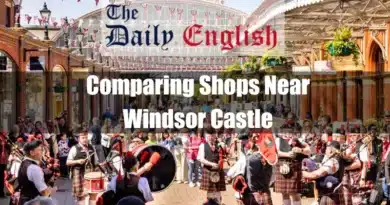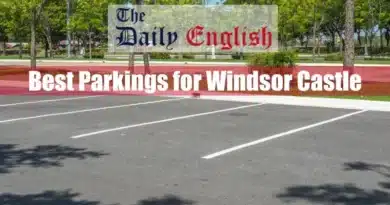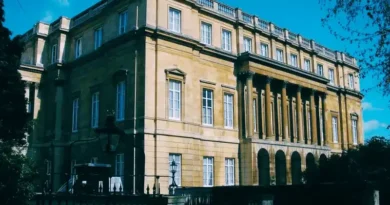Get to Windsor Castle From Bradford
Key Points
- The distance from Bradford to Windsor Castle is approximately 207 miles (333 kilometres) via the M1, 219 miles (352 kilometres) via the M1 and M40, and 216 miles (348 kilometres) via the A1. The best option to travel from Bradford to Windsor Castle depends on your priorities—speed, convenience, or cost.
- The fastest and most efficient method is by train, taking approximately 3 hours and 57 minutes via Leeds, London King’s Cross, the Underground to Paddington, then Great Western Railway to Slough, and a short final train to Windsor & Eton Central.
- By car, the quickest route is via the M1, covering 207 miles in around 3 hours and 47 minutes, though traffic can cause delays. Alternative car routes via the M40 or A1 are slightly longer but may be preferable depending on road conditions.
- Cycling is an ambitious but scenic option, covering around 220 miles over nearly 20 hours via National Cycle Route 6. Overall, the train provides the best balance of speed, comfort, and reliability.
Key Points Comparison Table
| Mode of Transport | Route | Distance (miles) | Estimated Travel Time | Key Considerations |
|---|---|---|---|---|
| Car | M1 (Fastest Route) | 207 | ~3h 47m | Heavy traffic on M1 and M25 during peak hours; roadworks and closures possible. |
| M1 and M40 | 219 | ~3h 56m | Slightly longer but can be an alternative if M1 traffic is high. | |
| A1 | 216 | ~4h 15m | Offers a balance between efficiency and simplicity; delays at major junctions. | |
| Train | Via Leeds, King’s Cross, Paddington, Slough | N/A | ~3h 57m | Fastest route with multiple transfers; efficient underground connection. |
| Via Leeds, King’s Cross, Vauxhall, Windsor & Eton Riverside | N/A | ~4h 17m | Fewer underground changes; slightly longer travel time. | |
| Via Leeds, Stevenage, Thameslink, Paddington, Slough | N/A | ~4h 19m | Longer waiting times at some interchanges. | |
| Cycle | Via National Cycle Route 6 | 220 | ~19h 32m | Urban and countryside mix; elevation gain of 5,079 feet. |
| Via National Cycle Routes 6 and 57 | 217 | ~19h 29m | Higher elevation gain (6,499 feet); diverse terrain. | |
| Via National Cycle Route 5 | 232 | ~20h 53m | Longest route with challenging terrain; restricted sections require planning. |
Getting to Windsor Castle from Bradford by Car
Route 1: M1 (Fastest Route)
Travelling from Bradford to Windsor Castle by car is a straightforward journey, primarily using the M1 motorway. Under optimal traffic conditions, the total distance is approximately 207 miles, with a travel time of around 3 hours and 47 minutes.
Step 1: Exiting Bradford
- Begin your journey from Bradford city centre.
- Take Godwin Street, Manchester Road (A641), and continue onto Spring Mill Street.
- Follow Gaythorne Road and A6177 until you reach M606.
- Merge onto M606 and continue southwards.
Step 2: Joining the Motorway Network
- Use the right two lanes to turn slightly right onto M606.
- Take the M62 (East) exit towards M1/Hull/Leeds/Dewsbury.
- Use the right lane to merge onto M62.
- Stay on M62 for approximately 9.1 miles.
- Take the exit for M1 towards Wakefield.
- Merge onto M1 and follow it for approximately 166 miles.
- At Junction 6A, use the 3rd lane from the left to exit onto M25 towards Heathrow/M40/M4.
- Travel for around 18.8 miles on M25.
- At Junction 15, merge onto M4 towards Slough.
- Take the A4 exit towards Colnbrook/B470/Datchet/Langley.
Step 3: Entering Windsor
- Follow B470 from Slough towards Windsor.
- At Langley Roundabout, take the second exit onto Major’s Farm Road/B470.
- Continue on B470, passing through London Road and High Street.
- Turn right onto Windsor Road/B470.
- Follow signs towards Thames Street/B3022 (note: parts of this road may be closed at certain times).
- Turn left onto Castle Hill, where you will reach Windsor Castle.
Route 2: M1 and M40

The M1 and M40 route is a reliable option for those travelling from Bradford to Windsor Castle. Under ideal conditions, the journey spans approximately 3 hours and 56 minutes over a distance of 219 miles. Below is a step-by-step guide to ensure a smooth journey, including necessary tools and precautions.
Route Breakdown
- Departing from Bradford
- Begin on Manchester Rd/A641 and head towards M606.
- Follow A6181 south onto Manchester Rd/A641 for 1.3 miles.
- Take a slight left and continue onto A6177, then follow the road for 0.4 miles to reach M606.
- Following the M62, M1, and M69
- Take the M606 towards M62/M1.
- Merge onto M62 and travel 6.1 miles, then keep right for another 3 miles.
- Exit onto M1 and follow for 90.2 miles.
- Exit onto M69 at Coventry and continue 16.4 miles towards Coventry Eastern Bypass/A46.
- Getting onto M40
- Continue on A46 via Coventry Eastern Bypass.
- Merge onto Kenilworth Bypass/A46, continuing onto Warwick Bypass.
- Take the M40 ramp towards London/Banbury.
- Taking M40 and A404 to Slough
- Travel 62.9 miles on M40.
- Take the A404 exit towards Maidenhead.
- Follow A404(M) to M4 and merge.
- Travel 4.4 miles on M4, then exit onto A355.
- Final Leg to Windsor Castle
- Travel 2.8 miles via Royal Windsor Way/A332 and Clarence Rd.
- Follow B3022 towards Castle Hill.
- Arrive at Windsor Castle.
Cautions and Considerations
- Traffic Conditions: Major roads such as M1, M40, and M4 can experience congestion, especially during peak hours. Plan to travel outside rush hours to avoid delays.
- Road Closures: Parts of B3022 near Windsor may be closed at certain times. Always check traffic updates before departure.
- Fuel and Rest Stops: Service stations are available along M1, M40, and M4. Take advantage of these for fuel, food, and rest breaks.
Following these tips will ensure a smooth and efficient journey from Bradford to Windsor Castle. Safe travels!
Route 3: A1

If you are travelling from Bradford to Windsor Castle, taking the A1 route is a reliable option. Under ideal conditions, this route covers a distance of approximately 216 miles and takes around 4 hours and 15 minutes.
1. Departing Bradford
- Start your journey from Bradford, UK.
- Head south on Godwin St/A6181 towards Godwin St (0.3 mi).
- Continue onto Manchester Rd/A641 (1.3 mi).
- Slight left (0.1 mi).
- Use the middle lane to turn slightly left onto Mayo Ave/A6177 and continue (0.4 mi).
2. Getting onto the A1
- Use the right two lanes to turn slightly right onto M606 (signs for M62/M1) (2.2 mi).
- Take the exit toward M1/Hull/Leeds/Dewsbury/A638 (0.3 mi).
- At the Chain Bar Roundabout, take the 1st exit onto the M62 ramp to Hull/Leeds/M1 (0.2 mi).
- Merge onto M62 (6.1 mi), keeping right to stay on M62 (12.6 mi).
- At Junction 32A, use the left two lanes to take the A1(M) exit (0.2 mi).
- Continue onto A1(M) (2.7 mi), followed by A1 (7.7 mi).
- Continue on A1(M) (15.5 mi), A1 (72.5 mi), A1(M) (12.9 mi), and back onto A1 (4.8 mi).
- Take the 3rd exit at the roundabout and stay on A1 (8.0 mi).
- Keep right to continue on Great N Rd/A1 (259 ft).
3. Joining the M1
- Take the 2nd exit onto A421 (17.4 mi) at Black Cat Roundabout.
- Take the exit toward M1 South (0.3 mi).
- Use the left lane to take the ramp to Ampthill/Ridgmont/A507/A4012/M1 (371 ft).
- Merge onto Salford Rd (0.1 mi).
- At the roundabout, take the 2nd exit onto the M1 ramp to London (0.2 mi).
4. Travelling via M1 and M25
- Merge onto M1 (24.1 mi).
- At Junction 6A, use the 3rd lane from the left to take the M25 exit to M40/M4/Heathrow Airport (0.8 mi).
- Use the right lane to take the ramp onto M25 (18.8 mi).
- At Junction 15, use the left two lanes to merge onto M4 toward Slough (2.2 mi).
- Take the A4 exit toward Colnbrook/B470/Datchet/Langley (0.3 mi).
5. Reaching Windsor Castle
- At Langley Roundabout, take the 2nd exit onto Major’s Farm Rd/B470 (1.7 mi).
- Take the 2nd exit onto London Rd/B376/B470 (210 ft) at the roundabout.
- At the next roundabout, take the 1st exit onto High St/B470 (0.2 mi).
- Turn right onto Windsor Rd/B470 (1.4 mi).
- Turn left onto Thames St/B3022 (0.2 mi). Note: Parts of this road may be closed at certain times or days.
- Finally, turn left onto Castle Hill (266 ft), arriving at Windsor Castle.
Expect possible delays around major junctions such as M1 and M25 interchanges. This A1 route offers a balance between efficiency and straightforward navigation, making it a viable choice for reaching Windsor Castle from Bradford by car.
Getting to Windsor Castle From Bradford by Train
Travelling from Bradford to Windsor Castle by train involves multiple routes, varying journey durations, and different modes of transport. Depending on the chosen route, the total travel time can range between approximately 3 hours and 57 minutes to 4 hours and 19 minutes. The variation in journey length is influenced by the number of transfers, waiting times at interchange stations, and differences in train speeds and routes. Below is a detailed breakdown of these factors.
Route Variations and Travel Times
The fastest route from Bradford to Windsor Castle takes approximately 3 hours and 57 minutes. This journey includes multiple train changes and some walking between stations. The journey begins at Bradford Interchange with a train to Leeds, which takes around 19 minutes without any stops. After a brief one-minute walk, a second train departs from Leeds to London King’s Cross, lasting around 2 hours and 15 minutes, with six stops along the way.
Upon arrival in London, the journey involves an 11-minute underground transfer on the Circle and Hammersmith & City lines to Paddington Station, followed by a 15-minute train ride to Slough. After a very short walk, a final train journey of approximately six minutes from Slough to Windsor & Eton Central completes the trip. A final seven-minute walk leads to Windsor Castle.
Other routes take slightly longer, ranging from 4 hours and 17 minutes to 4 hours and 19 minutes. One alternative involves travelling through Vauxhall and using South Western Railway services. This journey also begins with the same initial steps to London King’s Cross. However, instead of taking the Circle and Hammersmith & City lines, this route involves an 11-minute ride on the Victoria Line to Vauxhall. A subsequent 49-minute train ride on the South Western Railway to Windsor & Eton Riverside follows. A final nine-minute walk completes the journey to Windsor Castle.
Factors Influencing Travel Time
The differences in travel time are primarily due to variations in:
- Number of Transfers and Interchange Times – The fastest route involves a direct underground transfer at King’s Cross to Paddington, which is efficient. However, routes requiring changes at additional stations, such as Vauxhall or Farringdon, introduce additional waiting times and potential delays.
- Train Frequency and Waiting Times – Some routes involve longer waiting times between connections. For example, the route passing through Stevenage includes a wait before transferring to a Thameslink service. Similarly, waiting times at Slough before boarding the Windsor-bound train can vary, contributing to the overall travel time.
- Train Speed and Stops – The LNER train from Leeds to London varies in duration based on the number of stops en route. Some services have more stops than others, slightly increasing the total travel time.
- Walking Distances Between Transfers – Certain routes require longer walking transfers between stations, such as moving from King’s Cross to St. Pancras for Thameslink services or navigating between underground lines. These walking distances, though short, contribute to overall journey time.
- Type of Train Service Used – Express services, such as the Great Western Railway (GWR) from Paddington to Slough, are faster than some stopping services. Conversely, routes using South Western Railway tend to be slightly longer due to more frequent stops along the way.
Choosing the Best Route
For the quickest journey, the route via Paddington and Slough is preferable, given its minimal waiting times and efficient underground transfer. However, for travellers who prefer fewer underground connections, the route via Vauxhall may be more convenient despite the slightly longer travel time.
Overall, while all routes require multiple transfers, planning according to preferred convenience—whether it be speed or fewer changes—will ensure a smooth journey from Bradford to Windsor Castle.
Getting to Windsor Castle From Bradford By Cycle
Embarking on a cycling journey from Bradford to Windsor Castle is an ambitious yet rewarding endeavour, offering a blend of urban landscapes, historic towns, and scenic countryside. The journey spans approximately 220 miles (354 kilometres) and can be undertaken via several routes, each presenting unique experiences and challenges.
Route Options
1. Via National Cycle Route 6
This route covers approximately 220 miles (354 kilometres) with an estimated cycling time of 19 hours and 32 minutes. It involves an elevation gain of 5,079 feet (1,548 metres) and a descent of 5,331 feet (1,625 metres), with elevation ranging from 49 feet (15 metres) to 640 feet (195 metres) above sea level. Notably, certain sections of this route have restricted usage or traverse private roads, necessitating prior planning to ensure accessibility.
2. Via National Cycle Routes 6 and 57
This alternative spans approximately 217 miles (349 kilometres) with an estimated cycling time of 19 hours and 29 minutes. The route features an elevation gain of 6,499 feet (1,981 metres) and a descent of 6,752 feet (2,058 metres), with elevation ranging from 26 feet (8 metres) to 643 feet (196 metres) above sea level. Combining Routes 6 and 57 offers a diverse cycling experience, though riders should be prepared for significant elevation changes.
3. Via National Cycle Route 5
The longest option, this route, extends approximately 232 miles (373 kilometres) with an estimated cycling time of 20 hours and 53 minutes. It includes an elevation gain of 5,846 feet (1,782 metres) and a descent of 6,096 feet (1,858 metres), with elevation ranging from 26 feet (8 metres) to 1,296 feet (395 metres) above sea level. Similar to the first option, certain sections have restricted usage or traverse private roads, requiring careful route planning.
Detailed Route Description
Starting in Bradford, cyclists will embark on National Cycle Route 6 (NCR 6), a major artery of the National Cycle Network that connects London to the Lake District, passing through cities such as Sheffield, Nottingham, and Leicester. The route offers a mix of traffic-free paths and on-road sections, showcasing the UK’s diverse landscapes and urban areas.
Key Waypoints and Highlights
- Sheffield: Approximately 40 miles (64 kilometres) southeast of Bradford, Sheffield is renowned for its industrial heritage and vibrant cultural scene. The city offers various amenities, making it a suitable rest stop.
- Nottingham: Further along NCR 6, Nottingham lies about 70 miles (113 kilometres) south of Sheffield. Known for the legend of Robin Hood and its historic castle, the city provides rich cultural experiences.
- Leicester: Continuing southward, Leicester is situated approximately 30 miles (48 kilometres) from Nottingham. The city boasts Roman ruins and a dynamic multicultural atmosphere.
- Milton Keynes: As you progress, Milton Keynes offers a network of redway paths, providing cyclists with safe and efficient routes through the town.
- Luton: Located about 20 miles (32 kilometres) southeast of Milton Keynes, Luton serves as a gateway to the Chiltern Hills, an Area of Outstanding Natural Beauty.
- St Albans: This historic city, approximately 15 miles (24 kilometres) south of Luton, features Roman heritage and medieval architecture.
- Windsor: The final destination, Windsor, is home to the iconic Windsor Castle, the oldest and largest inhabited castle globally. The town’s rich history and scenic Thames riverside make it a fitting conclusion to your journey.
Elevation Profile and Terrain
The route encompasses varied terrains, from urban environments to rolling countryside and occasional steep inclines, particularly when traversing the Pennines and the Chiltern Hills. Cyclists should prepare for elevation gains ranging from 5,000 to 6,500 feet (1,500 to 2,000 metres), depending on the chosen path. Regular training and proper gear are essential to manage these elevation changes effectively.
Route Conditions and Accessibility
While NCR 6 offers extensive coverage, certain segments may have restricted access or traverse private properties. It’s crucial to consult up-to-date maps and local guidelines to ensure compliance and avoid trespassing. Resources such as Sustrans provide detailed information on route conditions and accessibility.
Accommodation and Amenities
Along the route, numerous towns and cities offer accommodation options ranging from budget-friendly hostels to comfortable bed and breakfasts. Planning overnight stops in cities like Sheffield, Nottingham, and Milton Keynes can provide rest and recuperation. Additionally, these urban centres offer bike repair shops, eateries, and cultural attractions, enriching your cycling experience.
Safety Considerations
- Traffic Awareness: While many sections of NCR 6 are traffic-free, cyclists will encounter on-road segments, especially when passing through urban areas. Adherence to traffic laws and the use of high-visibility clothing are recommended for safety.
- Route Planning: Given the potential for restricted access to certain sections, thorough route planning is essential. Utilize reliable mapping tools and local resources to identify permissible paths.
- Physical Preparedness: The journey’s length and elevation changes require a good level of fitness. Regular training and conditioning are advisable before undertaking the trip.
Cycling from Bradford to Windsor Castle is a substantial undertaking that rewards riders with diverse landscapes, historic landmarks, and a profound sense of achievement.
By carefully selecting your route, preparing adequately, and staying informed about local conditions, you can ensure a memorable and fulfilling cycling adventure.
Conclusion
Travelling from Bradford to Windsor Castle offers multiple options, each with its own advantages. The train provides the best balance of speed, comfort, and reliability while driving offers flexibility, and cycling presents a challenging yet scenic adventure. Choosing the most suitable method depends on personal priorities such as travel time, convenience, and cost.









